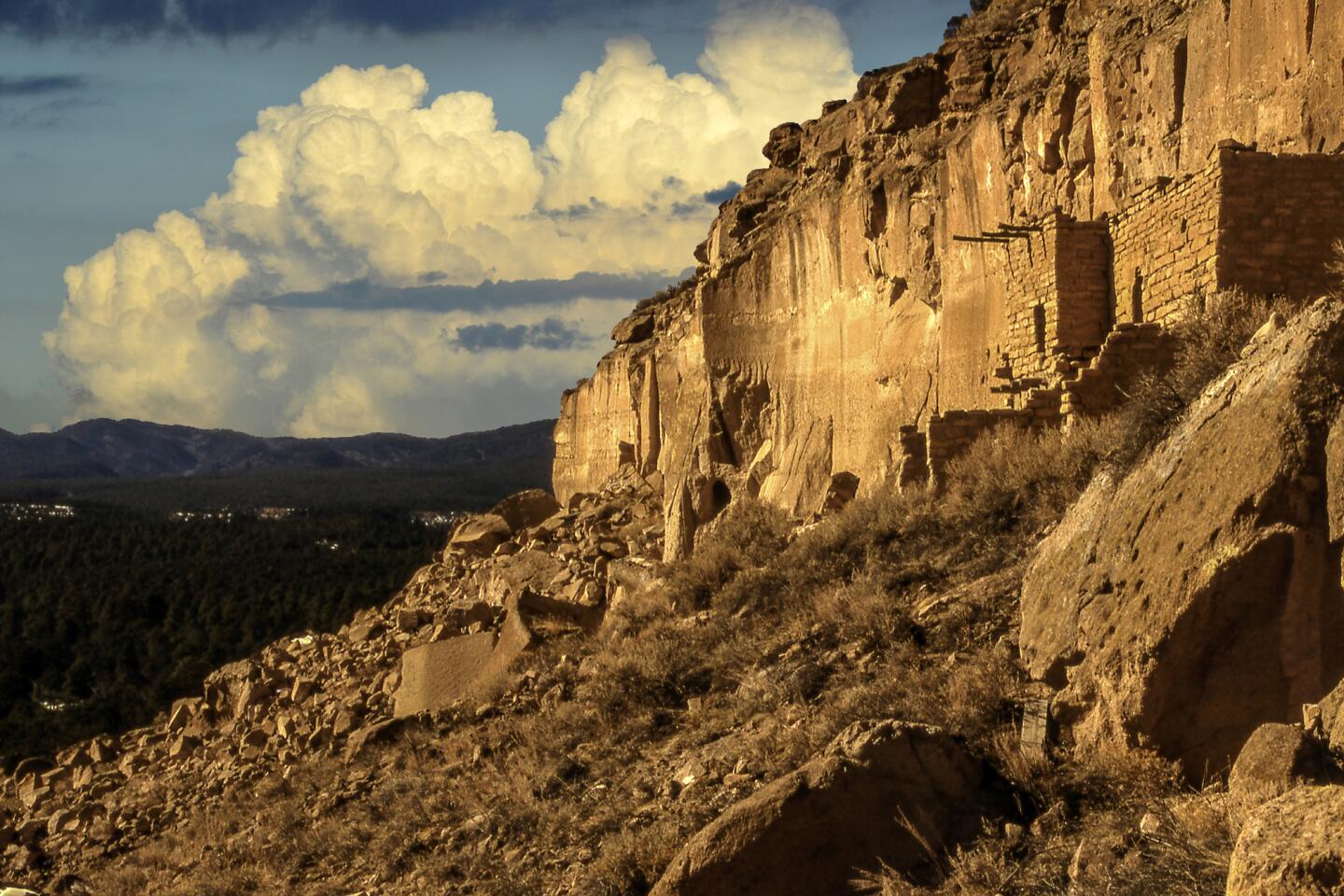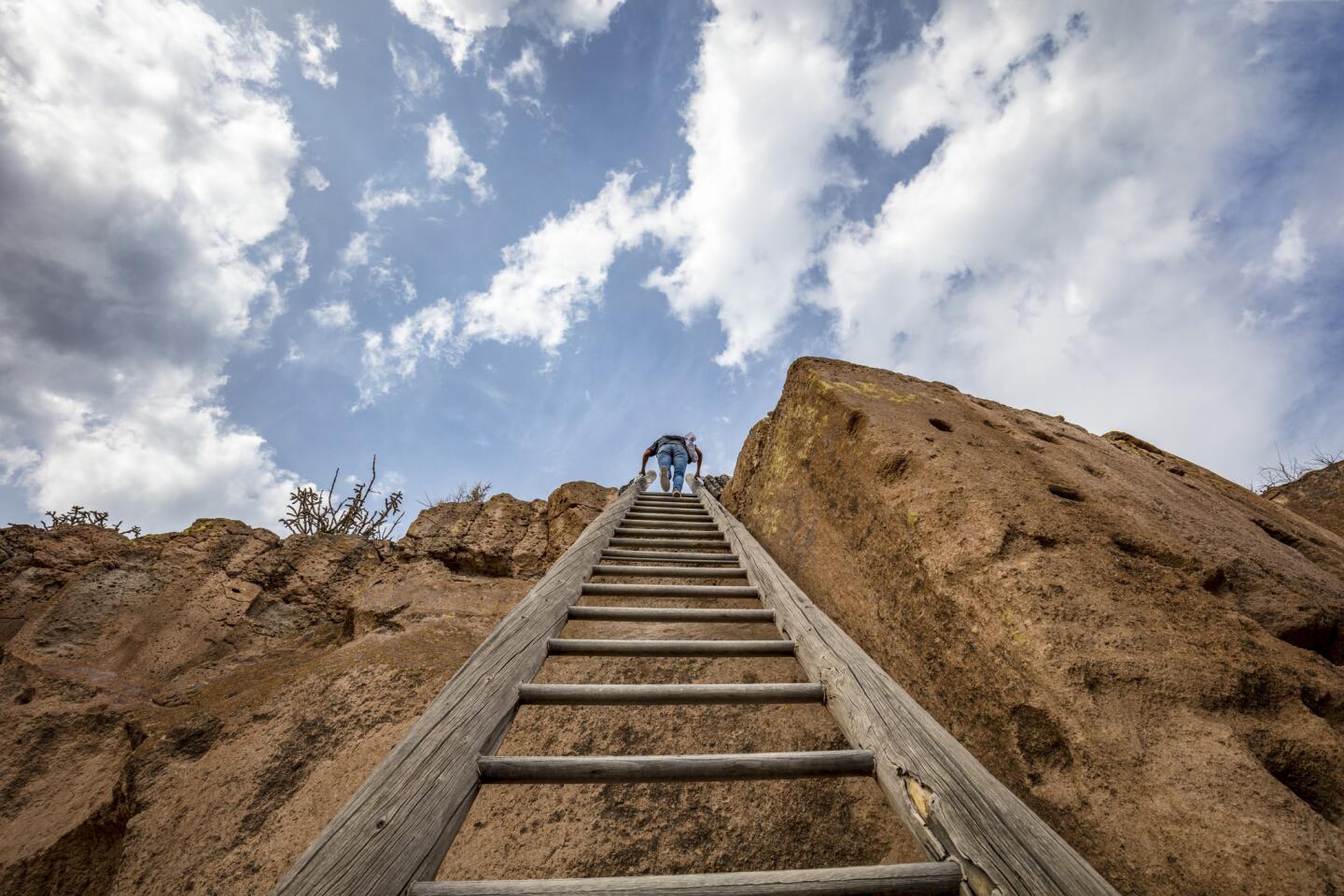At Puye Cliffs, N.M., travelers are in the grasp of a fascinating Native American history
- Share via
Reporting from Puye Cliffs, N.M — We silenced our phones as we stood among remnants of an ancient Native American village, trying to imagine the daily activity 1,000 years ago on this remote mesa.
As gusts of wind whistled, we closed our eyes and pictured men hunting with bows and arrows, women shaping clay pottery and children racing to and fro.
Barbara, my wife, and I were drawn to the site to learn more about the history and culture of New Mexico’s Native Americans, whose settlements are known as pueblos.
The Puye Cliff Dwellings offer an open-air learning lab with stunning views and a chance to gain an appreciation for a simpler way of life. Early fall, when foliage puts on its annual show, and summer are excellent times to visit.
We arrived at the 1930s-era Puye visitor center, once part of a chain of restaurants run by Fred Harvey, who helped popularize tourism in the West starting in the late 1800s.
The site and tours of the Puye Cliff Dwellings, about 30 miles north of Santa Fe, are now managed by members of the Santa Clara Pueblo, direct descendants of the Tewa-language people who inhabited the area from about 980 to about 1600. The site was declared a National Historic Landmark in 1966.
The south face of the Puye Cliffs, marked by cliff dwellings of different dimensions, extends a mile across the Pajarito Plateau of northern New Mexico. The dwellings were carved with wooden tools by early inhabitants from the mesa’s tuff — the compacted ash that was spewed by the Valles Caldera volcano, geologists say, more than 1 million years ago.
We paid a tour fee and hopped aboard a van, which took us to the top of the mesa and ruins of more than 100 rooms. The Tewa used the rooms for food storage and as living spaces in the spring and summer after relocating from their winter homes in the cliffs.
Our 360-degree view from the mesa (elevation 7,100-feet plus) extended from the Taos Mountains in the north to the Sandia Mountains, near Albuquerque, in the south.
As we walked among the ancient structures, guide Elija Naranjo-Smith described the daily life of his ancestors. They were self-sufficient, he said, growing corn, beans and squash, gathering piñon nuts and hunting deer, elk and rabbits.
Puye, he said, means “the place where rabbits gather.”
Many mesa dwellings were excavated by Edgar Lee Hewett in the early 1900s. In one corner of the mesa he led reconstruction of a two-story community house, resembling the mesa’s original two- or three-level structures.
Hewett, a renowned anthropologist, was banned from the location after he removed skeletal remains from burial sites. No excavations have occurred since then in honor of the site’s sacred status, Naranjo-Smith said.
Arrowheads and pottery shards along the cliff trails and mesa offer silent testimony about the Tewa village population that, at its peak, numbered about 2,500, said Alex Suazo, Puye’s operations manager.
I tiptoed down a ladder to a rebuilt kiva. In the solitude, I imagined Tewa elders gathered in a circle for prayer. (The kiva is the only spot where photography is not permitted.)
The Tewa, or ancient ones, were originally from the Mesa Verde/Four Corners region. They lived in the Puye Cliffs and similar nearby dwellings — largely in peace — for about 600 years, Naranjo-Smith said.
The mesa gave the village an exceptional position from which to watch for possible invaders. As an additional defensive measure, the dwellings, constructed with blocks of pumice-like tuff, had tiny door openings.
Some sources indicate that the Puye village’s first contact with Europeans occurred in 1541 during the Spanish expedition led by Francisco Vázquez de Coronado. That might have occurred, but there is no written record of the encounter, said Richard Flint, expedition historian and author.
Journals kept by the Spanish expedition show that a party of men traveled north to Taos along the nearby Rio Grande Valley.
Tour guide Naranjo-Smith told us a severe drought about 1600 forced the Puye’s inhabitants to move about 10 miles east to that same valley. There the Tewa later came into contact with Spanish authorities and missionaries, who named their village the Santa Clara Pueblo. (There are five other nearby Tewa-language pueblos.)
As the priests worked to convert the people of the pueblos to Catholicism, they banned their sacred dances and traditions and imposed harsh punishments. Many, including religious leaders, were killed or died of illnesses brought by the Spaniards.
The Tewa of Santa Clara joined other pueblos in reprisal. They attacked the Spanish settlers and priests in an uprising known as the Pueblo Revolt of 1680.
Ironically, the pueblo tribes, who spoke different languages, could coordinate their attack because they had learned a common language — Spanish.
Although they suffered heavy casualties, the pueblo attackers killed about 400 settlers and clergy and succeeded in driving the Spaniards from what is now New Mexico.
The pueblos resumed their ancient practices. A dozen years later, the Spanish returned and reconquered the region but muted some of their cruel practices, enhancing the bridging of the Spanish and Indian cultures.
Today, among New Mexico’s 19 pueblos, the Santa Clara Pueblo is a vibrant community with a hotel, casino and golf course in nearby Española. Its potters are nationally known for their exquisite polychrome redware and black-on-polished-black pottery.
As the sun bore down on us at the mesa, we returned in the van to the informative exhibit center. But dozens of visitors each day climb down long ladders to inspect the cliff dwellings and numerous petroglyphs.
We took one last look at Puye, touted by its Tewa operators as “a magical place between Earth and sky.” The golden cliffs glistened in the late afternoon sun as, in the distance, tourists moved among the 1,000-year-old dwellings.
We headed back to Santa Fe with a newly acquired knowledge and stories to share.
If you go
The Puye Cliff Dwellings, Highway 30 and Santa Clara Canyon Road, Española, N.M.; (505) 917-6650, lat.ms/puyecliffs. Open 8 a.m.-4 p.m. through the end of March. (Call after winter snowfall for hours of operation.) Beginning in April: 8 a.m.-6 p.m. One-hour guided tours of the mesa or the cliff dwellings begin at 9 a.m. and cost $20 a person, $18 for seniors and children. Two-hour tours of the cliff face, Puye village and mesa start at 8 a.m., 10 a.m., 1 p.m. and 3 p.m., $35; $33 for seniors and children.
“Earth & Sky” events take place Oct. 14 from 9 a.m.-3 p.m., featuring pueblo dances, bread-making demonstrations using hornos (outdoor ovens), local art vendors and tours. An “Archaeology Day” from 9 a.m.-3 p.m. on Nov. 18 offers similar activities as well as information on other archaeology sites. Special events are free with regular admission.
More to Read
Sign up for The Wild
We’ll help you find the best places to hike, bike and run, as well as the perfect silent spots for meditation and yoga.
You may occasionally receive promotional content from the Los Angeles Times.








